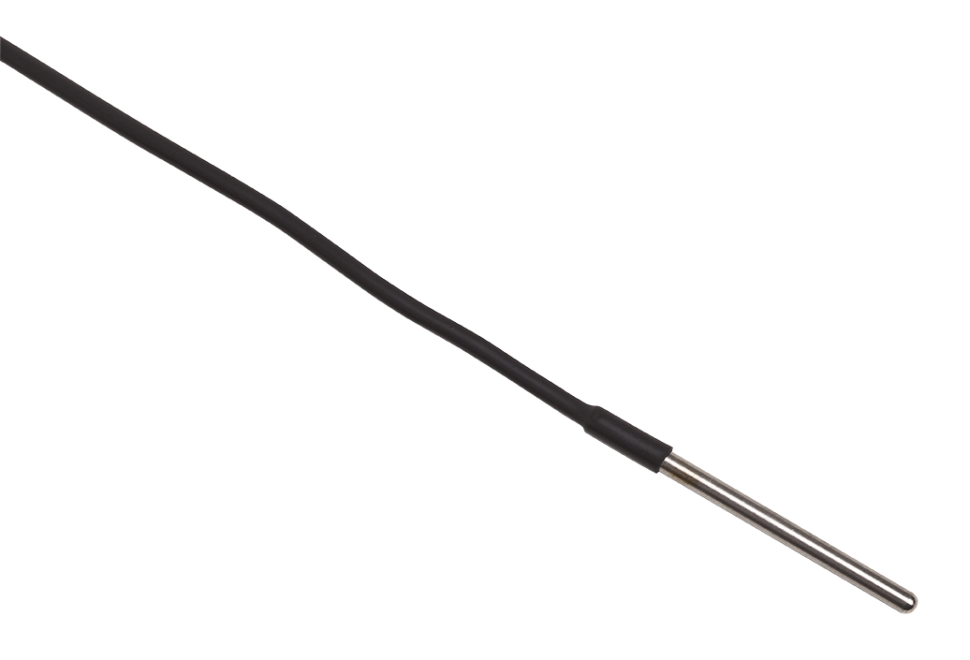Description
The 5606 is just two inches (50 mm) in length with a sheath diameter of 1/8 inch (3.1 mm). Since it can be fully immersed over its entire temperature range, you don’t have to worry about calculating minimum immersion depth— immerse the entire probe, transition junction, and lead wires, in either non-corrosive liquids or dry mediums ranging from –200 °C to 160 °C.
The 100 Ω precision sensing element (alpha = 0.00385) is specially constructed to prevent the ingress of moisture while achieving calibration accuracies as good as ± 0.05 °C. You get both accuracy and flexibility built into a small, durable package.
The lead wires of the 5606 are made of single-conductor enameled copper wire which prevents moisture from wicking to the sensing element as it would if a more common, stranded lead wire were used. The diameter of the lead wire is no greater than 0.2 mm, making it easy to run lead wires through a freezer door to your readout or transmitter with effectively zero energy loss. The 5606 has been proven in common heat transfer fluids such as silicone oil, mineral oil, ethanol, and even liquid nitrogen with no degradation of the transition junction seal or lead wire insulation.
Spécifications
| General Specifications |
| Temperature range |
|
| Nominal resistance at 0.01 °C |
|
| Temperature coefficient |
|
| Accuracy[1] |
| ± 0.04 °C at 0.01 °C |
| ± 0.06 °C at 160 °C |
|
| Short-term repeatability[2] |
| ± 0.03 °C at 0.01 °C |
| ± 0.04 °C at 160 °C |
|
| Drift[3] |
| ± 0.03 °C at 0.01 °C |
| ± 0.04 °C at 160 °C |
|
| Hysteresis |
|
| Sheath length |
| 50 mm ± 5 mm |
| (2 in ± 0.2 in) |
|
| Sheath diameter |
| 3.1 mm ± 0.1 mm (1/8 in ± 0.004 in) |
|
| Sheath material |
|
| Transition junction temperature range[4] |
|
| Sensor length |
| 30 mm ± 3mm (1.2 in ±0.1 in) |
|
| Sensor location |
| 3 mm ± 1 mm from tip (1.2 in ± 0.04 in) |
|
| Minimum insulation resistance |
|
| Minimum immersion length |
|
| Maximum immersion depth in liquid medium |
|
| Response time[5] |
|
| Self heating (in 0 °C bath) |
|
| Lead-wire cable type |
|
| Lead-wire length |
|
| Lead-wire temperature range |
|
| Calibration |
| NVLAP accredited calibration included, lab code 200348-0 |
|
[1] Includes calibration and 100 hr drift (k = 2).
[2] Three thermal cycles from min to max temp, includes hysteresis, 95 % confidence (k = 2).
[3] After 100 hours at max temp, 95 % confidence (k = 2).
[4] Temperatures outside this range will cause irreparable damage.
[5] Per ASTM E 644.
| Calibration uncertainty |
|
5606 |
| Temperature |
1924 Calibration Uncertainty† |
| -197 °C |
0.03 °C |
| -38 °C |
0.03 °C |
| 0 °C |
0.03 °C |
| 100 °C |
0.045 °C |
| 157 °C |
0.05 °C |
† Lab code 200348-0
5606 meets ASTM E 1137 Grade A Classification of Tolerances.
R0: Enter the R0 value provided |



